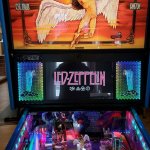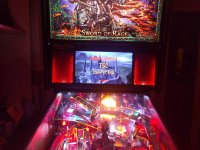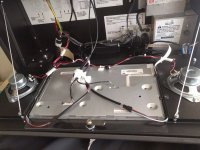#include <FastLED.h>
// D2..D5
#define LED_PIN0 4
#define LED_PIN1 5
#define COLOR_ORDER GRB
#define CHIPSET WS2811
#define NUM_LEDS 39
#define BRIGHTNESS 200
#define FRAMES_PER_SECOND 40
CRGB leds[4][NUM_LEDS];
// Fire2012 with programmable Color Palette
//
// This code is the same fire simulation as the original "Fire2012",
// but each heat cell's temperature is translated to color through a FastLED
// programmable color palette, instead of through the "HeatColor(...)" function.
//
// Four different static color palettes are provided here, plus one dynamic one.
//
// The three static ones are:
// 1. the FastLED built-in HeatColors_p -- this is the default, and it looks
// pretty much exactly like the original Fire2012.
//
// To use any of the other palettes below, just "uncomment" the corresponding code.
//
// 2. a gradient from black to red to yellow to white, which is
// visually similar to the HeatColors_p, and helps to illustrate
// what the 'heat colors' palette is actually doing,
// 3. a similar gradient, but in blue colors rather than red ones,
// i.e. from black to blue to aqua to white, which results in
// an "icy blue" fire effect,
// 4. a simplified three-step gradient, from black to red to white, just to show
// that these gradients need not have four components; two or
// three are possible, too, even if they don't look quite as nice for fire.
//
// The dynamic palette shows how you can change the basic 'hue' of the
// color palette every time through the loop, producing "rainbow fire".
CRGBPalette16 gPal;
void setup() {
delay(3000); // sanity delay
FastLED.addLeds<CHIPSET, LED_PIN0, COLOR_ORDER>(leds[0], 2 * NUM_LEDS).setCorrection( TypicalLEDStrip );
FastLED.addLeds<CHIPSET, LED_PIN1, COLOR_ORDER>(leds[2], 2 * NUM_LEDS).setCorrection( TypicalLEDStrip );
FastLED.setBrightness( BRIGHTNESS );
// This first palette is the basic 'black body radiation' colors,
// which run from black to red to bright yellow to white.
//gPal = HeatColors_p;
gPal = CRGBPalette16( CRGB::Black, CRGB::Red, CRGB::Orange);
// These are other ways to set up the color palette for the 'fire'.
// First, a gradient from black to red to yellow to white -- similar to HeatColors_p
// gPal = CRGBPalette16( CRGB::Black, CRGB::Red, CRGB::Yellow, CRGB::White);
// Second, this palette is like the heat colors, but blue/aqua instead of red/yellow
// gPal = CRGBPalette16( CRGB::Black, CRGB::Blue, CRGB::Aqua, CRGB::White);
// Third, here's a simpler, three-step gradient, from black to red to white
// gPal = CRGBPalette16( CRGB::Black, CRGB::Red, CRGB::White);
}
void loop()
{
// Add entropy to random number generator; we use a lot of it.
random16_add_entropy( random());
// Fourth, the most sophisticated: this one sets up a new palette every
// time through the loop, based on a hue that changes every time.
// The palette is a gradient from black, to a dark color based on the hue,
// to a light color based on the hue, to white.
//
// static uint8_t hue = 0;
// hue++;
// CRGB darkcolor = CHSV(hue,255,192); // pure hue, three-quarters brightness
// CRGB lightcolor = CHSV(hue,128,255); // half 'whitened', full brightness
// gPal = CRGBPalette16( CRGB::Black, darkcolor, lightcolor, CRGB::White);
for (int i = 0; i < 4; i++)
Fire2012WithPalette(i, !(i & 1)); // run simulation frame, using palette colors
FastLED.show(); // display this frame
FastLED.delay(1000 / FRAMES_PER_SECOND);
}
// Fire2012 by Mark Kriegsman, July 2012
// as part of "Five Elements" shown here: http://youtu.be/knWiGsmgycY
////
// This basic one-dimensional 'fire' simulation works roughly as follows:
// There's a underlying array of 'heat' cells, that model the temperature
// at each point along the line. Every cycle through the simulation,
// four steps are performed:
// 1) All cells cool down a little bit, losing heat to the air
// 2) The heat from each cell drifts 'up' and diffuses a little
// 3) Sometimes randomly new 'sparks' of heat are added at the bottom
// 4) The heat from each cell is rendered as a color into the leds array
// The heat-to-color mapping uses a black-body radiation approximation.
//
// Temperature is in arbitrary units from 0 (cold black) to 255 (white hot).
//
// This simulation scales it self a bit depending on NUM_LEDS; it should look
// "OK" on anywhere from 20 to 100 LEDs without too much tweaking.
//
// I recommend running this simulation at anywhere from 30-100 frames per second,
// meaning an interframe delay of about 10-35 milliseconds.
//
// Looks best on a high-density LED setup (60+ pixels/meter).
//
//
// There are two main parameters you can play with to control the look and
// feel of your fire: COOLING (used in step 1 above), and SPARKING (used
// in step 3 above).
//
// COOLING: How much does the air cool as it rises?
// Less cooling = taller flames. More cooling = shorter flames.
// Default 55, suggested range 20-100
#define COOLING 55
// SPARKING: What chance (out of 255) is there that a new spark will be lit?
// Higher chance = more roaring fire. Lower chance = more flickery fire.
// Default 120, suggested range 50-200.
#define SPARKING 100
void Fire2012WithPalette(unsigned leds_idx, bool reverse)
{
// Array of temperature readings at each simulation cell
static uint8_t heats[4][NUM_LEDS];
uint8_t* heat = heats[leds_idx];
// Step 1. Cool down every cell a little
for( int i = 0; i < NUM_LEDS; i++) {
heat[i] = qsub8( heat[i], random8(0, ((COOLING * 10) / NUM_LEDS) + 2));
}
// Step 2. Heat from each cell drifts 'up' and diffuses a little
for( int k= NUM_LEDS - 1; k >= 2; k--) {
heat[k] = (heat[k - 1] + heat[k - 2] + heat[k - 2] ) / 3;
}
// Step 3. Randomly ignite new 'sparks' of heat near the bottom
if( random8() < SPARKING ) {
int y = random8(7);
heat[y] = qadd8( heat[y], random8(160,255) );
}
// Step 4. Map from heat cells to LED colors
for( int j = 0; j < NUM_LEDS; j++) {
// Scale the heat value from 0-255 down to 0-240
// for best results with color palettes.
uint8_t colorindex = scale8( heat[j], 240);
CRGB color = ColorFromPalette( gPal, colorindex);
int pixelnumber;
if( reverse ) {
pixelnumber = (NUM_LEDS-1) - j;
} else {
pixelnumber = j;
}
leds[leds_idx][pixelnumber] = color;
}
}






